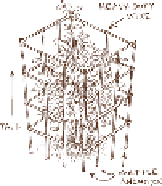Agriculture Reference
In-Depth Information
let them go and the plants will find their way, or vines can be trained, which will help plants grow in a
preferred direction.
Trellises support vertical growth, which saves space.
SUPPORTING TOMATOES
Regardless of what tomato varieties your gardeners choose, the plants will need some form of physical
support as they grow. Particularly in allotment gardens, where every square inch of ground is precious,
keeping tomatoes growing up makes everything easier.
Tomato support structures—commonly referred to as cages—come in many styles, including
square, round, conical, and ladder-shaped. They cost anywhere from one to ten dollars. Flimsy cages
that look like they're made of coat hanger wire won't provide adequate support, so don't bother with
these. Look for cages that are tall and made of heavy-gauge wire, with multiple, long anchor points that
will extend securely into the soil. These may cost a few dollars more, but are worth the investment.
For determinate tomatoes, a 4- or 5-foot cage is usually sufficient. If you're using a cone-shaped
cage, gardeners will want to add a stake to the plant as well. This will help keep the plant growing up-
right, and the cage will be less likely to tip over. Use a tall, heavy piece of wood or metal for the stake.
Insert it into the soil about 2 inches away from the plant's stem, and secure it to the stem periodically as
the plant grows.
Indeterminate tomatoes require heavy-duty support. They grow all season long and can produce
plants from 6 to 10 feet tall, depending on the variety. That's a lot of foliage and a lot of weight, espe-
cially once fruit production starts. So plan accordingly. If a raised bed is situated near a wall, fence, or
other vertical structure, gardeners can secure tomato cages to these for added support.
A good tomato cage offers significant support.




